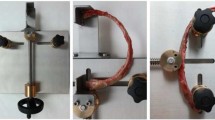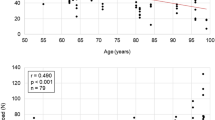Abstract
Literature on timing of rib trauma is scarce but remains challenging during forensic cases. This study analysed the macroscopic fracture patterns of perimortem rib fractures and compared them to experimentally reproduced rib fractures on fresh and dry ribs. Six distinctive macroscopic traits were found in ribs that might provide information about the timing of trauma, fracture mechanism and/or trauma circumstances. These traits are peels, folds, differential fracture edges, incomplete fractures, plastic deformation and longitudinal lines. Peels, folds and plastic deformation might provide information about trauma timing. Folds and different fracture edges might provide information about the fracture mechanism. Statistical analyses showed that longitudinal lines, folds and incomplete fractures might provide information about the trauma circumstances and that age might have an influence on the occurrence of complete fractures, longitudinal lines and peels (p ≤ 0.05). The new insights presented in this study might be valuable for forensic anthropologists in rib trauma analysis.






Similar content being viewed by others
References
Sauer NJ, Simson LR (1984) Clarifying the role of forensic anthropologists in death investigations. J Forensic Sci 29:1081–1086
Galtés I (2013) Estudio Médico Forense del Cadáver en Mal Estado. In: Libro X Curso Patología Forense, Soc. Española Patol. forense, Logroño, pp 113–141
Tersigni-Tarrant MA, Shirley NR (2013) Forensic anthropology today. In: Tersigni-Tarrant MA, Shirley NR (eds) Forensic anthropology: an introduction. CRC Press, Florida, p 462
Symes SA, L’Abbé EN, Chapman EN et al (2012) Chapter 17: interpreting traumatic injury to bone in medicolegal investigations. In: Dirkmaat DC (ed) A companion to forensic anthropology. Wiley-Blackwell, pp 340–388
Galloway A, Zephro L, Wedel VL (2014) Diagnostic criteria for the determination of timing and fracture mechanism. In: Wedel VL, Galloway A (eds) Broken bones. Charles C Thomas, Springfield, p 479
Christensen AM, Passalacqua NV, Bartelink EJ (2014) Forensic anthropology: current methods and practice. Academic Press, Oxford, p 447
Cappella A, Amadasi A, Castoldi E, Mazzarelli D, Gaudio D, Cattaneo C (2014) The difficult task of assessing perimortem and postmortem fractures on the skeleton: a blind text on 210 fractures of known origin. J Forensic Sci 59:1598–1601
Symes SA, L’Abbé EN, Stull KE et al (2014) Chapter 13: Taphonomy and the timing of bone fractures in trauma analysis. In: Pokines JT, Symes SA (eds) Manual of forensic taphonomy. CRC Press, Florida, pp 341–365
Wedel VL, Galloway A (2014) Broken bones. Charles C. Thomas, Springfield, p 480
Love JC, Symes SA (2004) Understanding rib fracture patterns: incomplete and buckle fractures. J Forensic Sci 49:1153–1158
Daegling DJ, Warren MW, Hotzman JL, Self CJ (2008) Structural analysis of human rib fracture and implications for forensic interpretation. J Forensic Sci 53:1301–1307
Kieser JA, Weller S, Swain MV, Neil Waddell J, Das R (2013) Compressive rib fracture: peri-mortem and post-mortem trauma patterns in a pig model. Legal Med 15:193–201
Sirmali M, Türüt H, Topçu S, Gülhan E, Yazici U, Kaya S, Taştepe I (2003) A comprehensive analysis of traumatic rib fractures: morbidity, mortality and management. Eur J Cardiothorac Surg 24:133–138
Yang K, Lynch M, O’Donnell C (2011) “Buckle” rib fracture: an artifact following cardio-pulmonary resuscitation detected on postmortem CT. Legal Med 13:233–239
Subirana M, Galtés I, Malgosa A (2008) Lesiones cstales en antropología forense. Cuad Med Forense 14:251–268
Reichs KJ (1998) Forensic osteology: advances in the identification of human remains, 2nd edition. Charles C Thomas, Springfield. Charles C Thomas, Springfield, p 567
Sauer NJ (1998) The timing of injuries and manner of death: distinguishing among antemortem, perimortem, and postmortem trauma. In: Reichs KJ (ed) Forensic osteology: advances in the identification of human remains. Charles C. Thomas, Springfield, pp 321–132
Kieser J, Taylor M, Carr D (2013) Forensic Biomechanics, p:163
Mazess RB (1982) On aging bone loss. Clin Orthop Relat Res:239–252
Kieser J (2013) Biomechanics of bone and bony trauma. In: Kieser J, Taylor M, Carr D (eds) Forensic biomechanics. Wiley-Blackwell, Oxford, pp 35–70
Cappella A, Castoldi E, Sforza C, Cattaneo C (2014) An osteological revisitation of autopsies: comparing anthropological findings on exhumed skeletons to their respective autopsy reports in seven cases. Forensic Sci Int 244:315.e1–315315.e10
Ubelaker DH, Adams BJ (1995) Differentiation of perimortem and postmortem trauma using taphonomic indicators. J Forensic Sci 40:509–512
Dirkmaat DC (2012) A Companion to Forensic Anthropology, p 665
Scheirs S, Malgosa A, Sanchez-Molina D et al (2016) New insights in the analysis of blunt force trauma in human bones. Preliminary results. Int J Legal Med 131:867–875
Rubertsson S, Silfverstolpe J, Rehn L, Nyman T, Lichtveld R, Boomars R, Bruins W, Ahlstedt B, Puggioli H, Lindgren E, Smekal D, Skoog G, Kastberg R, Lindblad A, Halliwell D, Box M, Arnwald F, Hardig BM, Chamberlain D, Herlitz J, Karlsten R (2013) The Study Protocol for the LINC (LUCAS in Cardiac Arrest) Study: a study comparing conventional adult out-of-hospital cardiopulmonary resuscitation with a concept with mechanical chest compressions and simultaneous defibrillation. Scand J Trauma Resusc Emerg Med 21:5
Smekal D, Lindgren E, Sandler H, Johansson J, Rubertsson S (2014) CPR-related injuries after manual or mechanical chest compressions with the LUCAS™ device: a multicentre study of victims after unsuccessful resuscitation. Resuscitation 85:1708–1712
Acknowledgements
Special thanks go to the technicians and personnel staff of the Institute of Legal Medicine and Forensic Sciences of Catalonia (IMLCFC) and the GRABI research group.
Author information
Authors and Affiliations
Corresponding author
Ethics declarations
This study was approved by the Ethic Commission of Human and Animal Experimental Work (CEEAH) of the UAB, in compliance with the ethical regulations.
Rights and permissions
About this article
Cite this article
Scheirs, S., Langenhorst, W., Malgosa, A. et al. Perimortem fracture pattern in ribs by blunt force trauma. Int J Legal Med 132, 1205–1213 (2018). https://doi.org/10.1007/s00414-018-1806-8
Received:
Accepted:
Published:
Issue Date:
DOI: https://doi.org/10.1007/s00414-018-1806-8




